The Sodium and Potassium Content of the Most Commonly Available Street Foods in Tajikistan and Kyrgyzstan in the Context of the FEEDCities Project
Abstract
:1. Introduction
2. Materials and Methods
2.1. Food Sample Collection
2.2. Bromatological Analysis
2.3. Data Analysis
3. Results
4. Discussion
5. Conclusions
Acknowledgments
Author Contributions
Conflicts of Interest
References
- World Health Organization. Global Health Estimates 2015: Cause-Specific Mortality. Available online: http://www.who.int/healthinfo/global_burden_disease/estimates/en/index1.html (accessed on 20 May 2017).
- World Health Organization. Global Status Report on Noncommunicable Diseases 2010; World Health Organization: Geneva, Switzerland, 2011. [Google Scholar]
- World Health Organization. Global Health Observatory (GHO) Data. Premature NCD Deaths. Available online: http://www.who.int/gho/mortality_burden_disease/causes_death/region/en/ (accessed on 20 May 2017).
- Gaziano, T.A.; Bitton, A.; Anand, S.; Abrahams-Gessel, S.; Murphy, A. Growing epidemic of coronary heart disease in low- and middle-income countries. Curr. Probl. Cardiol. 2010, 35, 72–115. [Google Scholar] [CrossRef] [PubMed]
- Popkin, B.M.; Gordon-Larsen, P. The nutrition transition: Worldwide obesity dynamics and their determinants. Int. J. Obes. Relat. Metab. Disord. 2004, 28, S2–S9. [Google Scholar] [CrossRef] [PubMed]
- Popkin, B.M. Nutrition transition and the global diabetes epidemic. Curr. Diab. Rep. 2015, 15, 64. [Google Scholar] [CrossRef] [PubMed]
- Anand, S.S.; Hawkes, C.; de Souza, R.J.; Mente, A.; Dehghan, M.; Nugent, R.; Zulyniak, M.A.; Weis, T.; Bernstein, A.M.; Krauss, R.M.; et al. Food consumption and its impact on cardiovascular disease: Importance of solutions focused on the globalized food system: A report from the workshop convened by the world heart federation. J. Am. Coll. Cardiol. 2015, 66, 1590–1614. [Google Scholar] [CrossRef] [PubMed]
- Food and Agriculture Organization of the United Nations. Europe and Central Asia: Regional Overview of Food Insecurity 2016. The Food Insecurity Transition; Food and Agriculture Organization of the United Nations: Budapest, Hungary, 2017. [Google Scholar]
- Popkin, B.M. Global nutrition dynamics: The world is shifting rapidly toward a diet linked with noncommunicable diseases. Am. J. Clin. Nutr. 2006, 84, 289–298. [Google Scholar] [PubMed]
- Abe, S.K.; Stickley, A.; Roberts, B.; Richardson, E.; Abbott, P.; Rotman, D.; McKee, M. Changing patterns of fruit and vegetable intake in countries of the former soviet union. Public Health Nutr. 2013, 16, 1924–1932. [Google Scholar] [CrossRef] [PubMed]
- Lim, S.S.; Vos, T.; Flaxman, A.D.; Danaei, G.; Shibuya, K.; Adair-Rohani, H.; Amann, M.; Anderson, H.R.; Andrews, K.G.; Aryee, M.; et al. A comparative risk assessment of burden of disease and injury attributable to 67 risk factors and risk factor clusters in 21 regions, 1990–2010: A systematic analysis for the global burden of disease study 2010. Lancet 2012, 380, 2224–2260. [Google Scholar] [CrossRef]
- Mohan, S.; Campbell, N.R. Salt and high blood pressure. Clin. Sci. 2009, 117, 1–11. [Google Scholar] [CrossRef] [PubMed]
- He, F.J.; MacGregor, G.A. A comprehensive review on salt and health and current experience of worldwide salt reduction programmes. J. Hum. Hypertens. 2009, 23, 363–384. [Google Scholar] [CrossRef] [PubMed]
- Cohen, H.W.; Alderman, M.H. Sodium, blood pressure, and cardiovascular disease. Curr. Opin. Cardiol. 2007, 22, 306–310. [Google Scholar] [CrossRef] [PubMed]
- World Health Organization. Guideline: Sodium Intake for Adults and Children; World Health Organization: Geneva, Switzerland, 2012. [Google Scholar]
- Vinceti, M.; Filippini, T.; Crippa, A.; de Sesmaisons, A.; Wise, L.A.; Orsini, N. Meta-analysis of potassium intake and the risk of stroke. J. Am. Heart Assoc. 2016, 5. [Google Scholar] [CrossRef] [PubMed]
- Aburto, N.J.; Hanson, S.; Gutierrez, H.; Hooper, L.; Elliott, P.; Cappuccio, F.P. Effect of increased potassium intake on cardiovascular risk factors and disease: Systematic review and meta-analyses. BMJ 2013, 346, f1378. [Google Scholar] [CrossRef] [PubMed] [Green Version]
- World Health Organization. Guideline: Potassium Intake for Adults and Children; World Health Organization: Geneva, Switzerland, 2012. [Google Scholar]
- Rodrigues, S.L.; Baldo, M.P.; Machado, R.C.; Forechi, L.; Molina Mdel, C.; Mill, J.G. High potassium intake blunts the effect of elevated sodium intake on blood pressure levels. J. Am. Soc. Hypertens. 2014, 8, 232–238. [Google Scholar] [CrossRef] [PubMed]
- Zhang, Z.; Cogswell, M.E.; Gillespie, C.; Fang, J.; Loustalot, F.; Dai, S.; Carriquiry, A.L.; Kukina, E.V.; Hong, Y.; Merritt, R.; et al. Association between usual sodium and potassium intake and blood pressure and hypertension among us adults: Nhanes 2005–2010. PLoS ONE 2013, 8, e75289. [Google Scholar]
- Cook, N.R.; Obarzanek, E.; Cutler, J.A.; Buring, J.E.; Rexrode, K.M.; Kumanyika, S.K.; Appel, L.J.; Whelton, P.K. Trials of Hypertension Prevention Collaborative Research, G. Joint effects of sodium and potassium intake on subsequent cardiovascular disease: The trials of hypertension prevention follow-up study. Arch. Intern. Med. 2009, 169, 32–40. [Google Scholar] [CrossRef] [PubMed]
- Judd, S.E.; Aaron, K.J.; Letter, A.J.; Muntner, P.; Jenny, N.S.; Campbell, R.C.; Kabagambe, E.K.; Levitan, E.B.; Levine, D.A.; Shikany, J.M.; et al. High sodium:potassium intake ratio increases the risk for all-cause mortality: The reasons for geographic and racial differences in stroke (regards) study. J. Nutr. Sci. 2013, 2, e13. [Google Scholar] [CrossRef] [PubMed]
- Okayama, A.; Okuda, N.; Miura, K.; Okamura, T.; Hayakawa, T.; Akasaka, H.; Ohnishi, H.; Saitoh, S.; Arai, Y.; Kiyohara, Y.E. Dietary sodium-to-potassium ratio as a risk factor for stroke, cardiovascular disease and all-cause mortality in japan: The nippon data80 cohort study. BMJ Open 2016, 6, e011632. [Google Scholar] [CrossRef] [PubMed]
- World Health Organization. Diet, Nutrition and the Prevention of Chronic Disease: Report of a Joint WHO/FAO Expert Consultation; World Health Organization: Geneva, Switzerland, 2003. [Google Scholar]
- World Health Organization. European Food and Nutrition Action Plan 2015–2020; WHO Regional Office for Europe: Copenhagen, Denmark, 2015. [Google Scholar]
- Mendez, M.; Popkin, B.M. Globalization, urbanization and nutritional change in the developing world. Electron. J. Agric. Dev. Econ. 2004, 1, 220–241. [Google Scholar]
- Langellier, B.A. Consumption and expenditure on food prepared away from home among mexican adults in 2006. Salud Pública de México 2015, 57, 4–13. [Google Scholar] [CrossRef] [PubMed]
- Steyn, N.P.; McHiza, Z.; Hill, J.; Davids, Y.D.; Venter, I.; Hinrichsen, E.; Opperman, M.; Rumbelow, J.; Jacobs, P. Nutritional contribution of street foods to the diet of people in developing countries: A systematic review. Public Health Nutr. 2014, 17, 1363–1374. [Google Scholar] [CrossRef] [PubMed]
- World Health Organization. Feedcities Project: The Food Environment Description in Cities in Eastern Europe and Central Asia—Tajikistan; WHO Regional Office for Europe: Copenhagen, Denmark, 2017. [Google Scholar]
- World Health Organization. Feedcities Project: The Food Environment Description in Cities in Eastern Europe and Central Asia—Kyrgyzstan; WHO Regional Office for Europe: Copenhagen, Denmark, 2017. [Google Scholar]
- Food and Agriculture Organization of the United Nations. Selling Street and Snack Foods; Food and Agriculture Organization of the United Nations: Rome, Italy, 2011. [Google Scholar]
- KoBoToolbox. KoBoCollect (Version 1.4.3) [Mobile Application Software]. 2014. Available online: https://play.google.com/store/apps/details?id=org.koboc.collect.android (accessed on 3 April 2016).
- Moubarac, J.; Parra, D.C.; Cannon, G.; Monteiro, C.A. Food classification systems based on food processing: Significance and implications for policies and actions: A systematic literature review and assessment. Curr. Obes. Rep. 2014, 3, 256–272. [Google Scholar] [CrossRef] [PubMed]
- Vieira, E.; Soares, M.E.; Ferreira, I.; Pinho, O. Validation of a fast sample preparation procedure for quantification of sodium in bread by flame photometry. Food Anal. Methods 2012, 5, 430–434. [Google Scholar] [CrossRef]
- Food and Agriculture Organization of the United Nations. Proximate Analyses. Available online: http://www.fao.org/docrep/field/003/ab479e/ab479e03.htm (accessed on 12 June 2017).
- World Health Organization. Nutrient Profile Model; WHO Regional Office for Europe: Copenhagen, Denmark, 2015. [Google Scholar]
- Krebs-Smith, S.M.; Kott, P.S.; Guenther, P.M. Mean proportion and population proportion: Two answers to the same question? J. Am. Diet. Assoc. 1989, 89, 671–676. [Google Scholar] [PubMed]
- World Health Organization. Better Non-Communicable Disease Outcomes: Challenges and Opportunities for Health Systems. Kyrgyzstan Country Assessment; WHO Regional Office for Europe: Copenhagen, Denmark, 2014. [Google Scholar]
- World Health Organization. Better Non-Communicable Disease Outcomes: Challenges and Opportunities for Health Systems. Tajikistan Country Assessment; WHO Regional Office for Europe: Copenhagen, Denmark, 2015. [Google Scholar]
- World Health Organization. Mapping Salt Reduction Initiatives in the WHO European Region; WHO Regional Office for Europe: Copenhagen, Denmark, 2013. [Google Scholar]
- Anderson, C.A.; Appel, L.J.; Okuda, N.; Brown, I.J.; Chan, Q.; Zhao, L.; Ueshima, H.; Kesteloot, H.; Miura, K.; Curb, J.D.; et al. Dietary sources of sodium in China, Japan, the United Kingdom, and the United States, women and men aged 40 to 59 years: The intermap study. J. Am. Diet. Assoc. 2010, 110, 736–745. [Google Scholar] [CrossRef] [PubMed]
- He, F.J.; Campbell, N.R.; MacGregor, G.A. Reducing salt intake to prevent hypertension and cardiovascular disease. Rev. Panam. Salud Publica 2012, 32, 293–300. [Google Scholar] [CrossRef] [PubMed]
- Powles, J.; Fahimi, S.; Micha, R.; Khatibzadeh, S.; Shi, P.; Ezzati, M.; Engell, R.E.; Lim, S.S.; Danaei, G.; Mozaffarian, D.; et al. Global, regional and national sodium intakes in 1990 and 2010: A systematic analysis of 24 h urinary sodium excretion and dietary surveys worldwide. BMJ Open 2013, 3, e003733. [Google Scholar] [CrossRef] [PubMed] [Green Version]
- Weaver, C.M. Potassium and health. Adv. Nutr. 2013, 4, 368S–377S. [Google Scholar] [CrossRef] [PubMed]
- World Health Organization. Global Health Observatory Data Repository. Raised Blood Pressure (sbp ≥ 140 or dbp ≥ 90), Age-Standardized (%), Estimates by Country. Available online: http://apps.who.int/gho/data/node.main.A875STANDARD?lang=en (accessed on 20 May 2017).
- Batyraliev, T.A.; Makhmutkhodzhaev, S.A.; Kydyralieva, R.B.; Altymysheva, A.T.; Dzhakipova, R.S.; Zhorupbekova, K.S.; Ryskulova, S.T.; Knyazeva, V.G.; Kaliev, M.T.; Dzhumagulova, A.S. Prevalence of risk factors of non-communicable disease in Kyrgyzstan: Assessment using WHO STEPS approach. Kardiologiia 2016, 11, 86–90. [Google Scholar] [CrossRef]
- Aburto, N.J.; Ziolkovska, A.; Hooper, L.; Elliott, P.; Cappuccio, F.P.; Meerpohl, J.J. Effect of lower sodium intake on health: Systematic review and meta-analyses. BMJ 2013, 346, f1326. [Google Scholar] [CrossRef] [PubMed] [Green Version]
- He, F.J.; MacGregor, G.A. Effect of modest salt reduction on blood pressure: A meta-analysis of randomized trials. Implications for public health. J. Hum. Hypertens. 2002, 16, 761–770. [Google Scholar] [CrossRef] [PubMed]
- Trieu, K.; Neal, B.; Hawkes, C.; Dunford, E.; Campbell, N.; Rodriguez-Fernandez, R.; Legetic, B.; McLaren, L.; Barberio, A.; Webster, J. Salt reduction initiatives around the world—A systematic review of progress towards the global target. PLoS ONE 2015, 10, e0130247. [Google Scholar] [CrossRef] [PubMed]
- Hyseni, L.; Elliot-Green, A.; Lloyd-Williams, F.; Kypridemos, C.; O’Flaherty, M.; McGill, R.; Orton, L.; Bromley, H.; Cappuccio, F.P.; Capewell, S. Systematic review of dietary salt reduction policies: Evidence for an effectiveness hierarchy? PLoS ONE 2017, 12, e0177535. [Google Scholar] [CrossRef] [PubMed]
- Campbell, N.R.; Johnson, J.A.; Campbell, T.S. Sodium consumption: An individual’s choice? Int. J. Hypertens. 2012, 2012, 860954. [Google Scholar] [CrossRef] [PubMed]
- Webster, J.L.; Dunford, E.K.; Neal, B.C. A systematic survey of the sodium contents of processed foods. Am. J. Clin. Nutr. 2010, 91, 413–420. [Google Scholar] [CrossRef] [PubMed]
- La Croix, K.W.; Fiala, S.C.; Colonna, A.E.; Durham, C.A.; Morrissey, M.T.; Drum, D.K.; Kohn, M.A. Consumer detection and acceptability of reduced-sodium bread. Public Health Nutr. 2015, 18, 1412–1418. [Google Scholar] [CrossRef] [PubMed]
- Girgis, S.; Neal, B.; Prescott, J.; Prendergast, J.; Dumbrell, S.; Turner, C.; Woodward, M. A one-quarter reduction in the salt content of bread can be made without detection. Eur. J. Clin. Nutr. 2003, 57, 616–620. [Google Scholar] [CrossRef] [PubMed]
- Hendriksen, M.A.; Verkaik-Kloosterman, J.; Noort, M.W.; van Raaij, J.M. Nutritional impact of sodium reduction strategies on sodium intake from processed foods. Eur. J. Clin. Nutr. 2015, 69, 805–810. [Google Scholar] [CrossRef] [PubMed]
- Goncalves, C.; Monteiro, S.; Padrao, P.; Rocha, A.; Abreu, S.; Pinho, O.; Moreira, P. Salt reduction in vegetable soup does not affect saltiness intensity and liking in the elderly and children. Food Nutr. Res. 2014, 58. [Google Scholar] [CrossRef] [PubMed] [Green Version]
- Van de Vijver, S.; Oti, S.; Addo, J.; de Graft-Aikins, A.; Agyemang, C. Review of community-based interventions for prevention of cardiovascular diseases in low- and middle-income countries. Ethn. Health 2012, 17, 651–676. [Google Scholar] [CrossRef] [PubMed]
- Kloss, L.; Meyer, J.D.; Graeve, L.; Vetter, W. Sodium intake and its reduction by food reformulation in the European Union—A review. NFS J. 2015, 1, 9–19. [Google Scholar] [CrossRef]
- Drewnowski, A.; Rehm, C.D.; Maillot, M.; Mendoza, A.; Monsivais, P. The feasibility of meeting the WHO guidelines for sodium and potassium: A cross-national comparison study. BMJ Open 2015, 5, e006625. [Google Scholar] [CrossRef] [PubMed]
- Estruch, R.; Ros, E.; Salas-Salvado, J.; Covas, M.I.; Corella, D.; Aros, F.; Gomez-Gracia, E.; Ruiz-Gutierrez, V.; Fiol, M.; Lapetra, J.; et al. Primary prevention of cardiovascular disease with a mediterranean diet. N. Engl. J. Med. 2013, 368, 1279–1290. [Google Scholar] [CrossRef] [PubMed]
- Panagiotakos, D.B.; Pitsavos, C.; Arvaniti, F.; Stefanadis, C. Adherence to the mediterranean food pattern predicts the prevalence of hypertension, hypercholesterolemia, diabetes and obesity, among healthy adults; the accuracy of the meddietscore. Prev. Med. 2007, 44, 335–340. [Google Scholar] [CrossRef] [PubMed]
- Sacks, F.M.; Svetkey, L.P.; Vollmer, W.M.; Appel, L.J.; Bray, G.A.; Harsha, D.; Obarzanek, E.; Conlin, P.R.; Miller, E.R.; Simons-Morton, D.G.; et al. Effects on blood pressure of reduced dietary sodium and the dietary approaches to stop hypertension (DASH) diet. Dash-sodium collaborative research group. N. Engl. J. Med. 2001, 344, 3–10. [Google Scholar] [CrossRef] [PubMed]
- Struijk, E.A.; May, A.M.; Wezenbeek, N.L.; Fransen, H.P.; Soedamah-Muthu, S.S.; Geelen, A.; Boer, J.M.; van der Schouw, Y.T.; Bueno-de-Mesquita, H.B.; Beulens, J.W. Adherence to dietary guidelines and cardiovascular disease risk in the epic-nl cohort. Int. J. Cardiol. 2014, 176, 354–359. [Google Scholar] [CrossRef] [PubMed]
- Reedy, J.; Krebs-Smith, S.M.; Miller, P.E.; Liese, A.D.; Kahle, L.L.; Park, Y.; Subar, A.F. Higher diet quality is associated with decreased risk of all-cause, cardiovascular disease, and cancer mortality among older adults. J. Nutr. 2014, 144, 881–889. [Google Scholar] [CrossRef] [PubMed]
- Wang, X.; Ouyang, Y.; Liu, J.; Zhu, M.; Zhao, G.; Bao, W.; Hu, F.B. Fruit and vegetable consumption and mortality from all causes, cardiovascular disease, and cancer: Systematic review and dose-response meta-analysis of prospective cohort studies. BMJ 2014, 349, g4490. [Google Scholar] [CrossRef] [PubMed] [Green Version]
- Afshin, A.; Micha, R.; Khatibzadeh, S.; Mozaffarian, D. Consumption of nuts and legumes and risk of incident ischemic heart disease, stroke, and diabetes: A systematic review and meta-analysis. Am. J. Clin. Nutr. 2014, 100, 278–288. [Google Scholar] [CrossRef] [PubMed]
- World Health Organization. Strategies to Monitor and Evaluate Population Sodium Consumptions and Sources of Sodium in the Diet: Report of a Joint Technical Meeting Convened by Who and the Government of Canada, October 2010; World Health Organization: Geneva, Switzerland, 2011. [Google Scholar]
- Iwahori, T.; Miura, K.; Ueshima, H. Time to consider use of the sodium-to-potassium ratio for practical sodium reduction and potassium increase. Nutrients 2017, 9. [Google Scholar] [CrossRef] [PubMed]
- Hawkes, C.; Webster, J. National approaches to monitoring population salt intake: A trade-off between accuracy and practicality? PLoS ONE 2012, 7, e46727. [Google Scholar] [CrossRef] [PubMed]
- Yatabe, M.S.; Iwahori, T.; Watanabe, A.; Takano, K.; Sanada, H.; Watanabe, T.; Ichihara, A.; Felder, R.A.; Miura, K.; Ueshima, H.; et al. Urinary sodium-to-potassium ratio tracks the changes in salt intake during an experimental feeding study using standardized low-salt and high-salt meals among healthy japanese volunteers. Nutrients 2017, 9. [Google Scholar] [CrossRef] [PubMed]
- Zganiacz, F.; Wills, R.B.H.; Mukhopadhyay, S.P.; Arcot, J.; Greenfield, H. Changes in the sodium content of australian processed foods between 1980 and 2013 using analytical data. Nutrients 2017, 9. [Google Scholar] [CrossRef] [PubMed]
- Pravst, I.; Lavrisa, Z.; Kusar, A.; Miklavec, K.; Zmitek, K. Changes in average sodium content of prepacked foods in Slovenia during 2011–2015. Nutrients 2017, 9. [Google Scholar] [CrossRef] [PubMed]
- World Health Organization. Global Action Plan for the Prevention and Control of Noncommunicable Diseases 2013–2020; World Health Organization: Geneva, Switzerland, 2013. [Google Scholar]

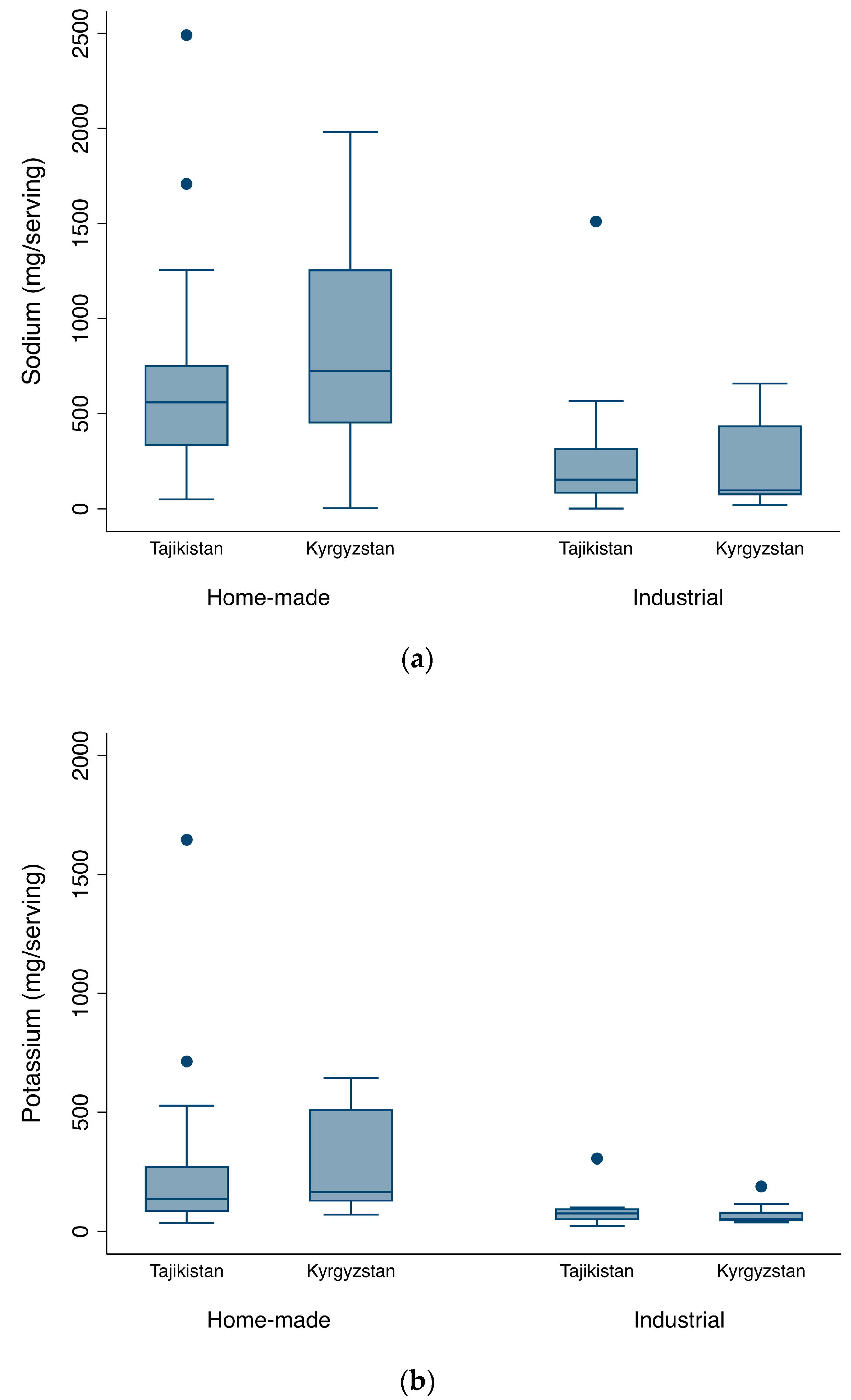
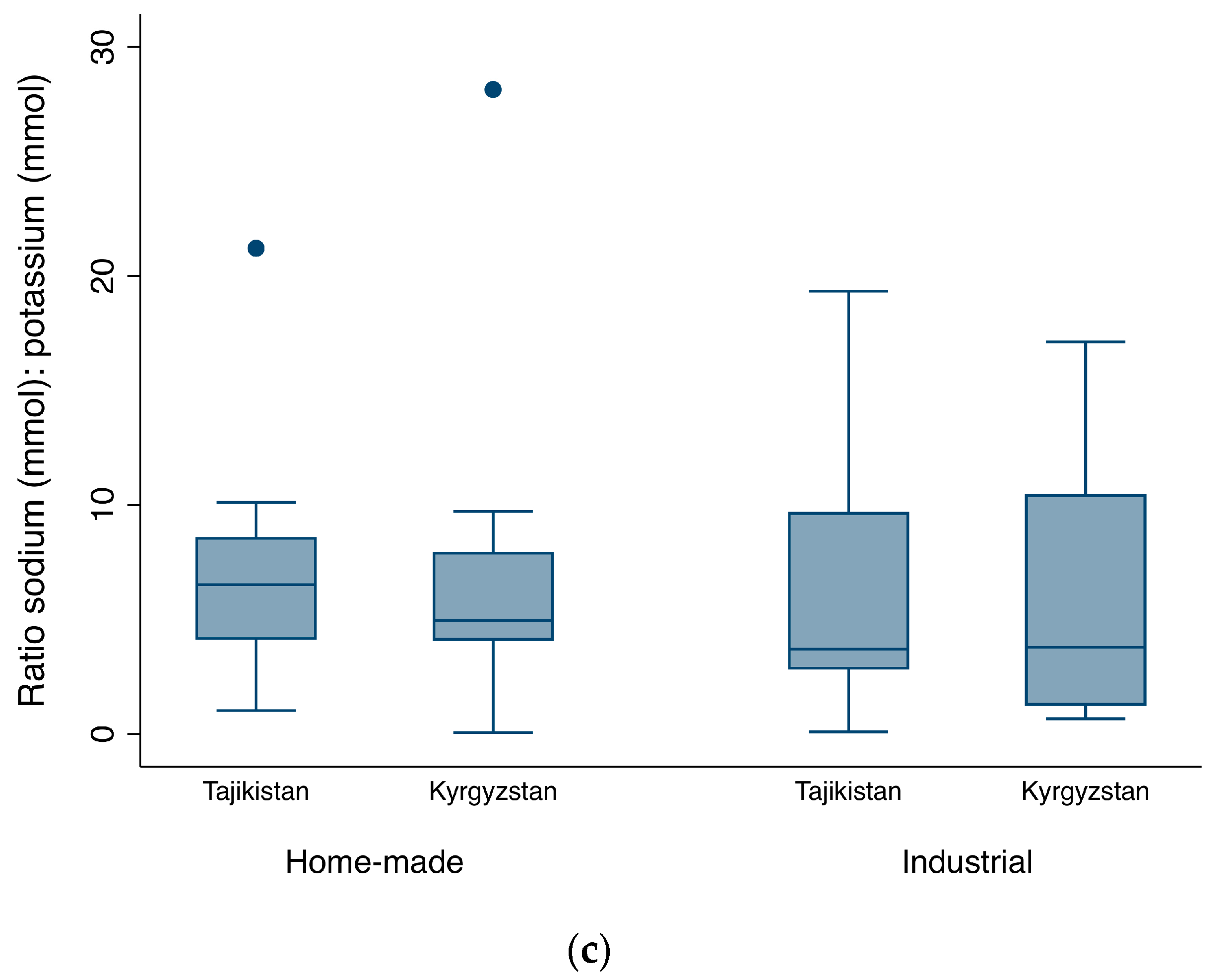
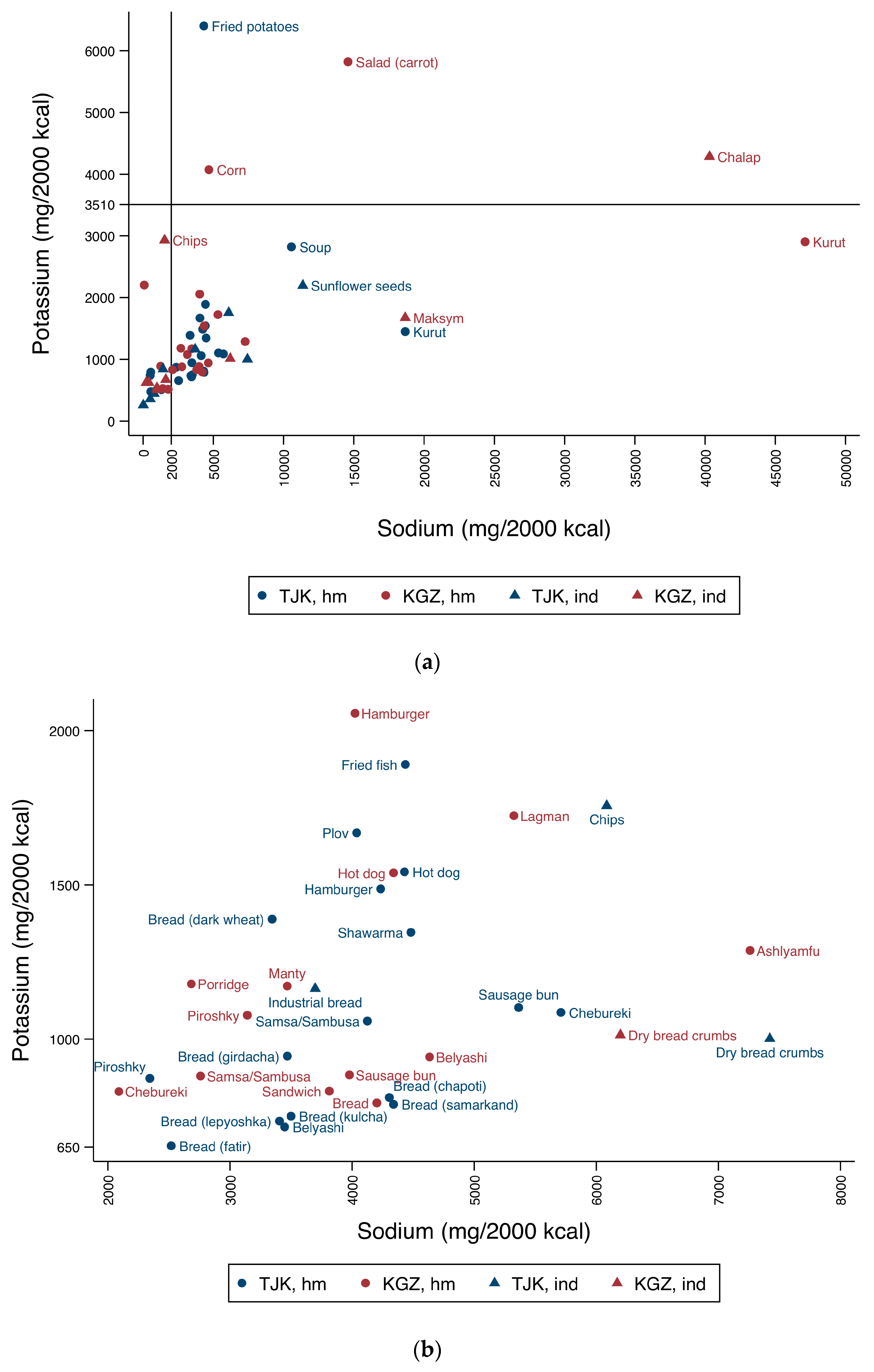
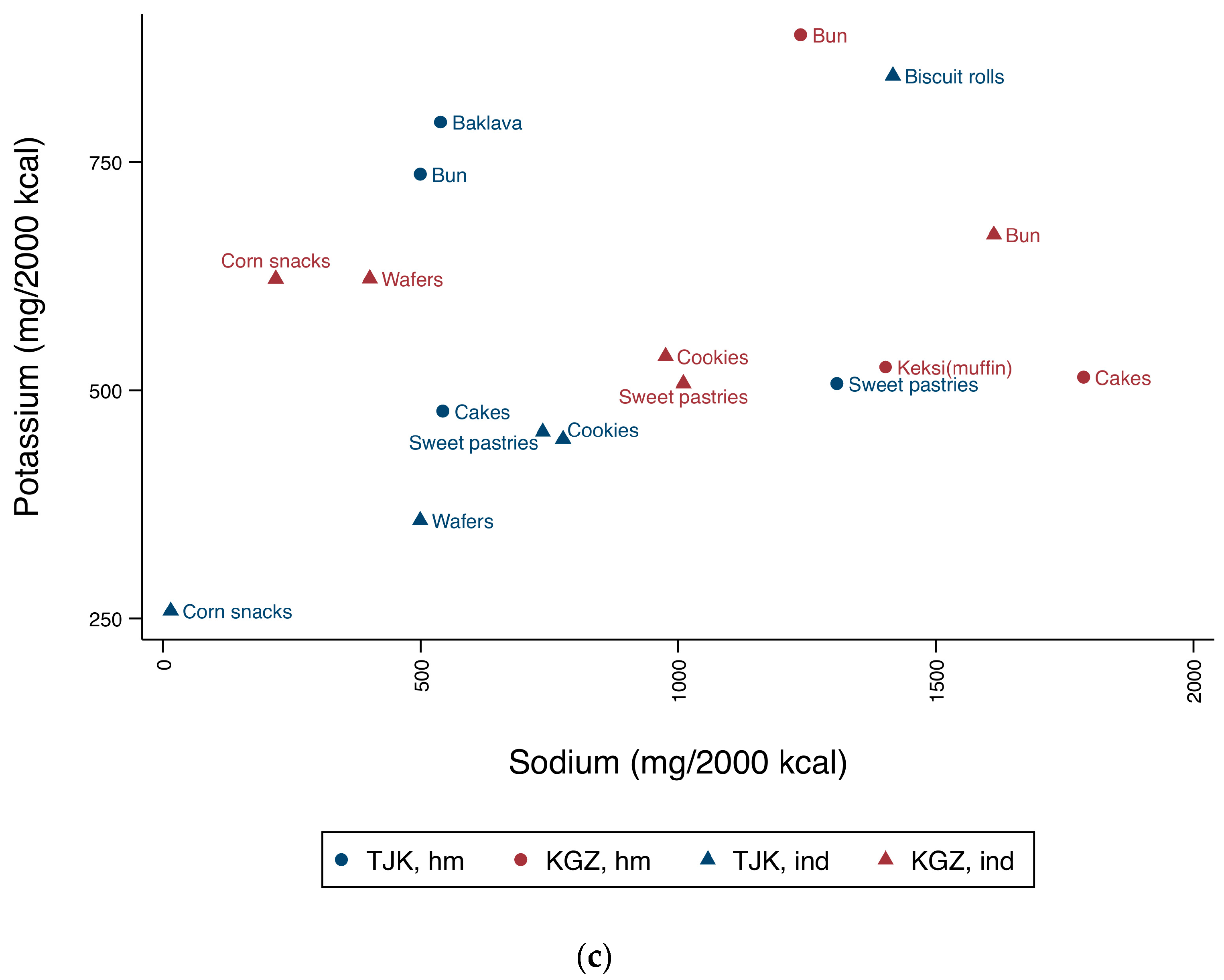
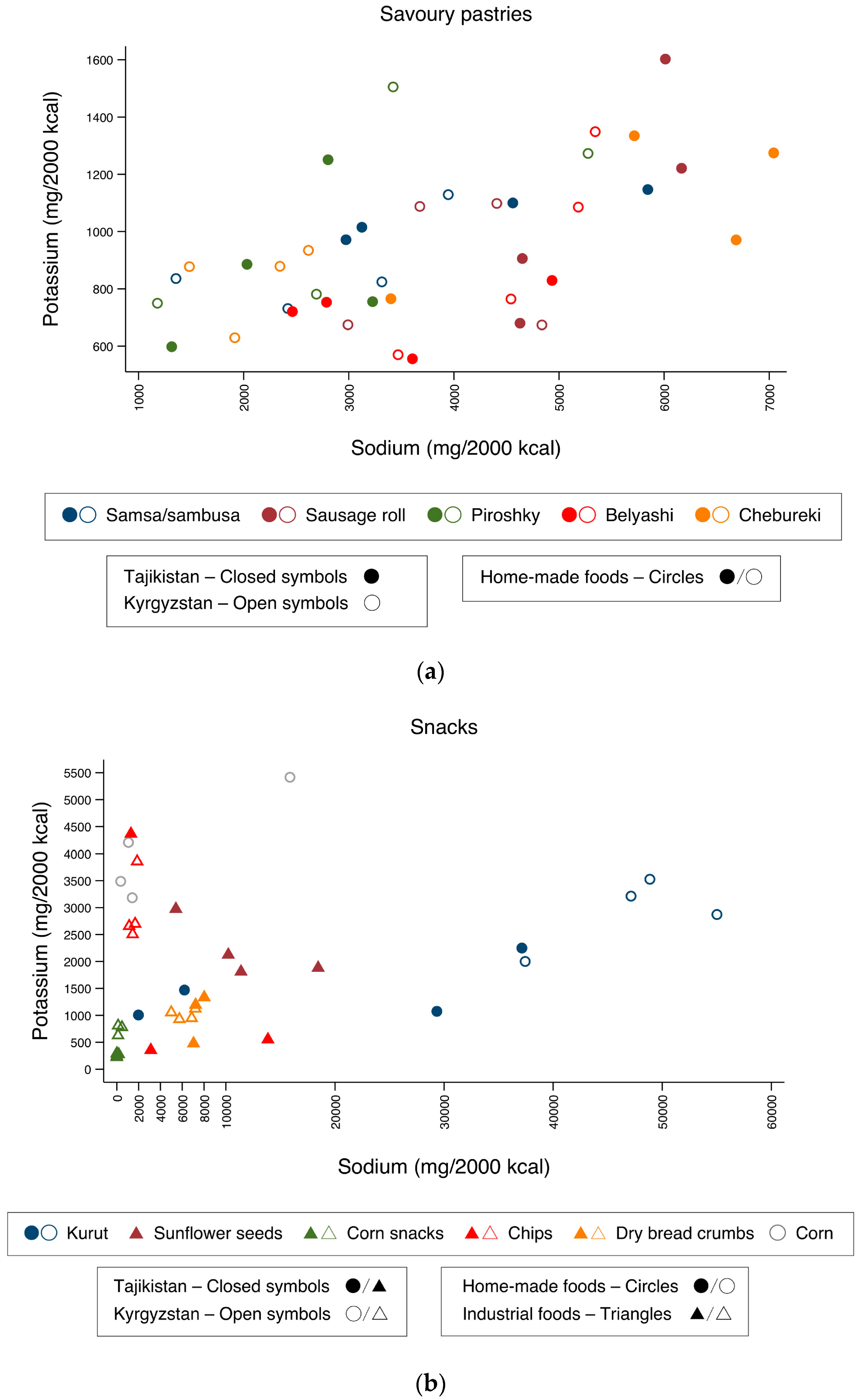

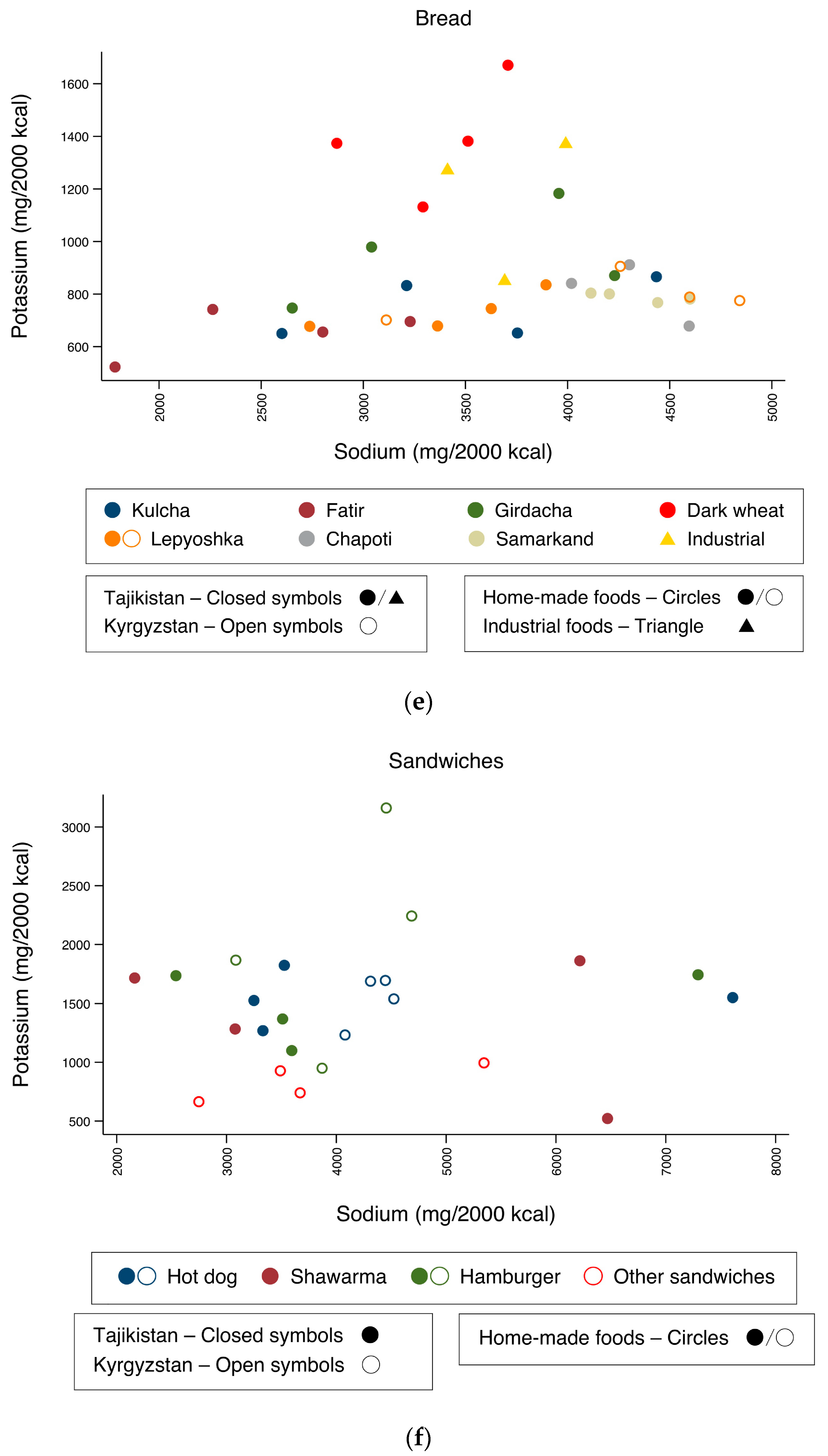
| Mean Serving Size (g) * | Na | K | Molar Na:K Ratio | ||||||||||
|---|---|---|---|---|---|---|---|---|---|---|---|---|---|
| Mean (Min–Max) * mg/Serving | % Recom. 1 | Mean (Min–Max) * mg/Serving | % Recom. 2 | Mean (Min–Max) * | |||||||||
| Tajikistan | |||||||||||||
| Industrial foods | N * | ||||||||||||
| Bread | 3 | 50.0 | 240 | 234 | 243 | 12.0 | 75 | 56 | 87 | 2.1 | 5.6 | 4.6 | 7.4 |
| Cakes and cookies | 14 | 59.1 | 103 | 30 | 238 | 5.2 | 66 | 21 | 133 | 1.9 | 3.1 | 0.7 | 7.2 |
| Snacks | 14 | 38.6 | 621 | 0 | 2218 | 31.0 | 129 | 17 | 447 | 3.7 | 10.2 | 0.0 | 42.6 |
| Home-made foods | N * | ||||||||||||
| Bread | 27 | 122.4 | 620 | 325 | 839 | 31.0 | 152 | 95 | 279 | 4.3 | 7.3 | 3.5 | 11.5 |
| Bun | 4 | 60.0 | 50 | 0 | 97 | 2.5 | 68 | 51 | 94 | 1.9 | 1.0 | 0.0 | 2.1 |
| Cakes and cookies | 11 | 88.2 | 112 | 45 | 275 | 5.6 | 105 | 31 | 169 | 3.0 | 2.4 | 0.6 | 4.9 |
| Main dishes | 16 | 361.4 | 1485 | 109 | 3724 | 74.2 | 788 | 55 | 1922 | 22.4 | 5.5 | 0.9 | 17.6 |
| Sandwiches | 12 | 222.4 | 962 | 442 | 1588 | 48.1 | 336 | 128 | 632 | 9.6 | 6.0 | 2.1 | 21.1 |
| Snacks | 4 | 18.0 | 559 | 50 | 1325 | 28.0 | 44 | 24 | 80 | 1.3 | 21.2 | 3.3 | 46.4 |
| Savoury pastries | 20 | 75.1 | 364 | 158 | 619 | 18.2 | 85 | 37 | 123 | 2.4 | 7.4 | 3.7 | 11.7 |
| Kyrgyzstan | |||||||||||||
| Industrial foods | N * | ||||||||||||
| Beverages | 8 | 200.0 | 579 | 432 | 986 | 29.0 | 67 | 42 | 115 | 1.9 | 16.4 | 8.8 | 29.4 |
| Bun | 4 | 45.5 | 127 | 5 | 381 | 6.3 | 47 | 37 | 65 | 1.3 | 3.8 | 0.2 | 10.0 |
| Cakes and cookies | 12 | 50.3 | 76 | 4 | 139 | 3.8 | 65 | 17 | 144 | 1.9 | 2.9 | 0.2 | 7.5 |
| Snacks | 12 | 31.6 | 183 | 9 | 528 | 9.2 | 104 | 25 | 244 | 3.0 | 4.0 | 0.2 | 12.3 |
| Home-made foods | N * | ||||||||||||
| Beverages | 4 | 200.0 | 4 | 0 | 15 | 0.2 | 82 | 13 | 122 | 2.3 | 0.1 | 0.0 | 0.2 |
| Bread | 4 | 120.0 | 720 | 521 | 867 | 36.0 | 135 | 117 | 149 | 3.9 | 9.0 | 7.5 | 10.6 |
| Bun | 4 | 66.2 | 132 | 115 | 157 | 6.6 | 91 | 63 | 116 | 2.6 | 2.6 | 1.8 | 3.5 |
| Cakes and cookies | 8 | 122.4 | 347 | 124 | 590 | 17.3 | 113 | 33 | 180 | 3.2 | 5.5 | 3.9 | 10.1 |
| Main dishes | 20 | 402.7 | 1409 | 241 | 2639 | 70.5 | 438 | 98 | 856 | 12.5 | 5.7 | 2.5 | 11.9 |
| Sandwiches | 12 | 222.1 | 1078 | 443 | 1858 | 53.9 | 423 | 107 | 1187 | 12.1 | 5.5 | 2.4 | 9.1 |
| Snacks | 8 | 150.5 | 861 | 66 | 1848 | 43.0 | 321 | 52 | 645 | 9.1 | 14.9 | 0.2 | 32.5 |
| Savoury pastries | 20 | 136.1 | 661 | 141 | 1424 | 33.0 | 178 | 90 | 407 | 5.1 | 6.3 | 2.7 | 12.2 |
© 2018 by the authors. Licensee MDPI, Basel, Switzerland. This article is an open access article distributed under the terms and conditions of the Creative Commons Attribution (CC BY) license (http://creativecommons.org/licenses/by/4.0/).
Share and Cite
Lança de Morais, I.; Lunet, N.; Albuquerque, G.; Gelormini, M.; Casal, S.; Damasceno, A.; Pinho, O.; Moreira, P.; Jewell, J.; Breda, J.; et al. The Sodium and Potassium Content of the Most Commonly Available Street Foods in Tajikistan and Kyrgyzstan in the Context of the FEEDCities Project. Nutrients 2018, 10, 98. https://doi.org/10.3390/nu10010098
Lança de Morais I, Lunet N, Albuquerque G, Gelormini M, Casal S, Damasceno A, Pinho O, Moreira P, Jewell J, Breda J, et al. The Sodium and Potassium Content of the Most Commonly Available Street Foods in Tajikistan and Kyrgyzstan in the Context of the FEEDCities Project. Nutrients. 2018; 10(1):98. https://doi.org/10.3390/nu10010098
Chicago/Turabian StyleLança de Morais, Inês, Nuno Lunet, Gabriela Albuquerque, Marcello Gelormini, Susana Casal, Albertino Damasceno, Olívia Pinho, Pedro Moreira, Jo Jewell, João Breda, and et al. 2018. "The Sodium and Potassium Content of the Most Commonly Available Street Foods in Tajikistan and Kyrgyzstan in the Context of the FEEDCities Project" Nutrients 10, no. 1: 98. https://doi.org/10.3390/nu10010098






